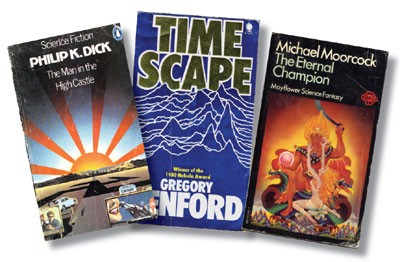doi.org/10.1038/448025a
Preview meta tags from the doi.org website.
Linked Hostnames
24- 37 links todoi.org
- 21 links towww.nature.com
- 8 links towww.springernature.com
- 4 links topartnerships.nature.com
- 3 links toauthorservices.springernature.com
- 2 links toidp.nature.com
- 2 links tosupport.nature.com
- 1 link tocitation-needed.springer.com
Thumbnail

Search Engine Appearance
Surfing the multiverse - Nature
The 'many worlds' of quantum mechanics spawned many more of science fiction. Yes, this is Nature. The cover art, by David Parkins, salutes a big year for quantum physics: 50 years ago, Hugh Everett III proposed what came to be known as the 'many worlds' hypothesis. He took quantum physics at face value, and imagined what it really meant. He aimed to resolve the paradoxes of quantum theory by allowing every possible outcome to every event to exist in its own world. In a News Feature, Mark Buchanan reports on modern reactions to the 'many worlds' idea. Although too bizarre for most physicists of the 1950s, many worlds theory now has its followers, including Max Tegmark, who laments in a Commentary that Everett's original paper is not as widely read as it should be. Tegmark also explains why he believes in parallel universes which, as Gary Wolfe illustrates in Books & Arts, are of course meat and drink to science fiction writers. Life sciences also have their place in this fiction-inspired issue and the whole is brought together in an Editorial.
Bing
Surfing the multiverse - Nature
The 'many worlds' of quantum mechanics spawned many more of science fiction. Yes, this is Nature. The cover art, by David Parkins, salutes a big year for quantum physics: 50 years ago, Hugh Everett III proposed what came to be known as the 'many worlds' hypothesis. He took quantum physics at face value, and imagined what it really meant. He aimed to resolve the paradoxes of quantum theory by allowing every possible outcome to every event to exist in its own world. In a News Feature, Mark Buchanan reports on modern reactions to the 'many worlds' idea. Although too bizarre for most physicists of the 1950s, many worlds theory now has its followers, including Max Tegmark, who laments in a Commentary that Everett's original paper is not as widely read as it should be. Tegmark also explains why he believes in parallel universes which, as Gary Wolfe illustrates in Books & Arts, are of course meat and drink to science fiction writers. Life sciences also have their place in this fiction-inspired issue and the whole is brought together in an Editorial.
DuckDuckGo
Surfing the multiverse - Nature
The 'many worlds' of quantum mechanics spawned many more of science fiction. Yes, this is Nature. The cover art, by David Parkins, salutes a big year for quantum physics: 50 years ago, Hugh Everett III proposed what came to be known as the 'many worlds' hypothesis. He took quantum physics at face value, and imagined what it really meant. He aimed to resolve the paradoxes of quantum theory by allowing every possible outcome to every event to exist in its own world. In a News Feature, Mark Buchanan reports on modern reactions to the 'many worlds' idea. Although too bizarre for most physicists of the 1950s, many worlds theory now has its followers, including Max Tegmark, who laments in a Commentary that Everett's original paper is not as widely read as it should be. Tegmark also explains why he believes in parallel universes which, as Gary Wolfe illustrates in Books & Arts, are of course meat and drink to science fiction writers. Life sciences also have their place in this fiction-inspired issue and the whole is brought together in an Editorial.
General Meta Tags
64- titleSurfing the multiverse | Nature
- titleClose banner
- titleClose banner
- X-UA-CompatibleIE=edge
- applicable-devicepc,mobile
Open Graph Meta Tags
6- og:urlhttps://www.nature.com/articles/448025a
- og:typearticle
- og:site_nameNature
- og:titleSurfing the multiverse - Nature
- og:descriptionYes, this is Nature. The cover art, by David Parkins, salutes a big year for quantum physics: 50 years ago, Hugh Everett III proposed what came to be known as the 'many worlds' hypothesis. He took quantum physics at face value, and imagined what it really meant. He aimed to resolve the paradoxes of quantum theory by allowing every possible outcome to every event to exist in its own world. In a News Feature, Mark Buchanan reports on modern reactions to the 'many worlds' idea. Although too bizarre for most physicists of the 1950s, many worlds theory now has its followers, including Max Tegmark, who laments in a Commentary that Everett's original paper is not as widely read as it should be. Tegmark also explains why he believes in parallel universes which, as Gary Wolfe illustrates in Books & Arts, are of course meat and drink to science fiction writers. Life sciences also have their place in this fiction-inspired issue and the whole is brought together in an Editorial.
Twitter Meta Tags
6- twitter:site@nature
- twitter:cardsummary_large_image
- twitter:image:altContent cover image
- twitter:titleSurfing the multiverse
- twitter:descriptionNature - Yes, this is Nature. The cover art, by David Parkins, salutes a big year for quantum physics: 50 years ago, Hugh Everett III proposed what came to be known as the 'many worlds'...
Item Prop Meta Tags
4- position1
- position2
- position3
- publisherSpringer Nature
Link Tags
15- alternatehttps://www.nature.com/nature.rss
- apple-touch-icon/static/images/favicons/nature/apple-touch-icon-f39cb19454.png
- canonicalhttps://www.nature.com/articles/448025a
- icon/static/images/favicons/nature/favicon-48x48-b52890008c.png
- icon/static/images/favicons/nature/favicon-32x32-3fe59ece92.png
Links
94- http://www.naturechina.com
- https://authorservices.springernature.com/go/sn/?utm_source=For+Authors&utm_medium=Website_Nature&utm_campaign=Platform+Experimentation+2022&utm_id=PE2022
- https://authorservices.springernature.com/language-editing
- https://authorservices.springernature.com/scientific-editing
- https://citation-needed.springer.com/v2/references/10.1038/448025a?format=refman&flavour=citation